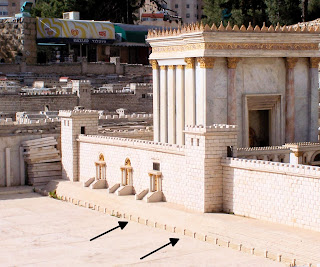Click on photo to enlarge it
When you ascend the Temple Mount in Jerusalem, you may think you are seeing the remains of what ancient worshipers saw when they were there. That is hardly the case. The Temple was destroyed by Titus in 70 AD, then Hadrian leveled the area again in 135 AD. Since then, while under Muslim control, nearly every vestige of the Temple has been removed.
There may be an exception to that - the remains of what Rabbi Chaim Richman and some archaeologists identify as the base of the soreg. The soreg was a low retaining wall that surrounded the Temple and served as a boundary—a line of demarcation or separation. No one was permitted to ascend beyond that point unless they had gone through purification rituals, and were otherwise permitted to “draw near to God.”
There were signs posted on the soreg in Greek and in Latin that warned unauthorized people against entering the area of the Holy Temple. The signs warned that anyone who went beyond the soreg was “liable.” These signs were similar to our “No Trespassing” signs today. You can see one of these marble tablets in the Israeli Museum in Jerusalem.
When the Greeks invaded the Temple [Antiochus Epiphanes and the story of Hanukkah], they broke 13 breaches in the soreg as a sign of their contempt for Jewish law. When the Hasmoneans, defeated Antiochus and purified the Temple, the religious rulers of the day decided to leave those breaches open. Richman said that when the Jews started going back to the Temple, they would lay themselves on the ground and offer thanks to God for the miracle of the defeat of the Greeks at the hand of the Hasmoneans.
Click on photo to enlarge it
[Photo taken of the Temple in the Jerusalem Model at the Israeli Museum]
Some commentators believe it was the soreg that Paul was referring to when he wrote to the Christ followers at Ephesus:
For He Himself is our peace, who has made both one, and has broken down the middle wall of separation [Ephesians 2:14].


Comments
Post a Comment